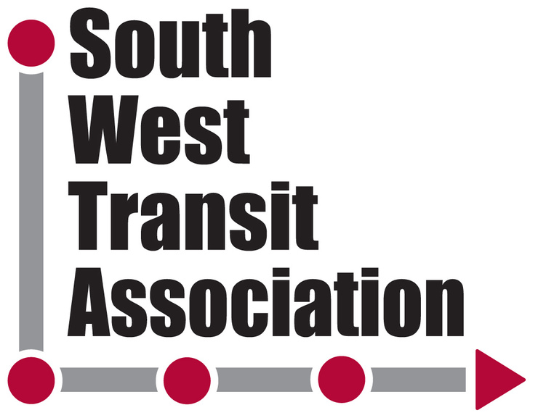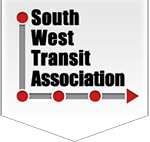South West Transit Association

SWTA Sends Letter on Behalf of Membership to Key Congressional Committee Staff Leaders June 22, 2015

Dear Chairman Ryan and Ranking Member Levin:
This letter is being sent on behalf of the 182 public transportation providers, businesses and members of the South West Transit Association, from the states of Arizona, Arkansas, Colorado, Kansas, Louisiana, New Mexico, Oklahoma and Texas.
I am writing to encourage the passage of a long-term transportation bill, with a sustainable, predictable source of revenue that will enable investment in our transportation infrastructure. Doing so will help sustain growth and opportunity for people in communities across our eight state region and the Nation.
The basic facts are:
- Americans took 10.8 billion trips on public transportation in 2014, which is the highest annual public transit ridership number in 58 years. This growth occurred in rural, small and large urban communities and across all modes. (source: American Public Transportation Association)
- The Highway Trust Fund cannot keep pace with growing demand from both the highway and transit programs. The current federal fuel tax level (18.4 cents per gallon), which has not been raised since 1993, is not enough. This is the key impediment to reauthorizing federal transportation legislation.
- Since 2009, Congress has funded transportation through a dozen short-term measures, ranging from one week to two years. This method of crisis management cripples our transit Agencies’ ability to provide adequate community services, disrupts plans for long term growth projects and halts economic progress due to poorly maintained equipment, roads and bridges.
Often the facts alone don’t allow you to see the full picture. To put a face with the data, local transit agencies have provided basic facts about how public transportation impacts the communities they serve.
Public transportation supports communities on a personal level by providing the way to jobs, healthcare and life events. Transit options increase economic health and save tax payers money.
Kibois Area Transit (KATS) in Stigler, Oklahoma serves an eleven county area that includes partnerships with tribal groups. From January 1, 2014 to December 31, 2014, KATS drove a total of 5,598,226.7 miles, completing 738,101 passenger trips. 65,725 of those trips took people to work. That means 292 people are able to go to work each day because of the consistent job KATS is doing. That’s 292 people are off welfare rolls in rural, eastern Oklahoma, living productive, tax paying lives because of their ride to work.
Colorado transit agencies are connecting people to what is important in life.
80% of ECO, the Eagle County, Colorado transit system trips get people to work.
59% of the Mountain Metro transit riders in Colorado Springs are going to work or school.
60% of workers in downtown Denver ride the RTD bus, train, carpool, walk, or ride a bike; they do not drive.
Public transportation supports communities by creating economic activity through public-private transit oriented development and by providing jobs to build and maintain services.
Investment in the Dallas Area Rapid Transit (DART) rail capital projects between 2003 and 2013 has generated a return of $7.4 billion in regional economic activity, creating more than 54,000 jobs that paid more than $3.3 billion in wages, salaries and benefits. In addition, more than $5.3 billion in private-capital transit-oriented development projects have been built, are under construction, or are currently planned near light rail stations since the debut of DART Rail in 1996.
Public transportation provides a way for America to be energy responsible, strong and independent.
Ozark Regional Transit Authority in Springdale, Arkansas just received four compressed natural gas vehicles into its’ fleet. The authority’s new vehicles cost $101,968 each for a total of $407,872. Roughly $345,000 came from the Surface Transportation Program under the Federal Highway Administration, while $60,000 was funded by a matching grant from the Northwest Arkansas Economic Development District and approximately $19,000 of the Authority’s own money. The four new buses will be used for routes in Springdale and for paratransit, which is door-to-door transportation for people with disabilities.
In addition to reduced emissions, CNG provides significant savings compared to gasoline. Fuel costs average between $0.75 to $0.80 less per gallon resulting in a savings of at least $6,900 per year, per bus.
Public transportation reduces congestion dramatically in and around metro areas, produces few carbon emissions and makes a safer community for all, providing additional benefits even to people not using transit. It makes the entire transportation system work more efficiently. For every ten people on a bus or train during rush hour equals nine fewer cars on the roads.
Out of 250,000 daily trips taken on Valley Metro, Phoenix, Arizona bus and light rail, one-third are work trips saving 3,300 pounds of pollution and reducing approximately 7,750 vehicles from the freeways and streets. Four hundred Valley Metro vanpools also help save five million drive-alone miles and 182,000 gallons of fuel each month.
The bottom line regarding congestion is economics: Time spent stuck in traffic can be converted to productivity. Increased productivity improves economic vitality and ultimately generates more money for individuals and the community.
A strong investment in capital projects for small and rural fleets allows public transportation providers to give safe and reliable service on a consistent basis. Currently, the following small systems are living with the choice-making reality of the cost of keeping older vehicles on the road versus cutting service.
Citibus, Lubbock, Texas Sixty-one percent (61%) of this system’s fleet is past its useful life. They currently operate fixed route, university service with 70 buses and paratransit service with 32 vans. The majority of both the university buses and the paratransit vans are beyond their useful life. In order to keep up with the demand for service, Citibus is forced to procure buses beyond useful life from neighboring DART. Parts are scavenged from the older DART vehicles and placed on the current Citibus fleet because some parts are on longer produced.
Fort Smith Transit, Fort Smith Arkansas Sixty-five percent (65%) of the vehicles in this system have met their useful life. They maintain 17 revenue vehicles in the fleet and operate 12 vehicles daily. Twenty-five percent (25%) of trips served are to or from medical appointments. Thirty-five percent (35%) are to or from employment destinations. The elderly and disabled residents comprise more than twenty-five percent (25%) of all passenger trips combined. Their average annual bus replacement needs equal three buses per year.
Santa Fe Trails, Santa Fe, New Mexico, currently has 36 full-size buses in the fleet, and 18 of those vehicles are past their useful life (by some three years and 150,000 miles). The latter bus model is no longer manufactured, and parts are all but impossible to find. They are only able to replace twelve of these buses at this time, which will reduce the fleet to 30 buses, thus reducing service. This causes Santa Fe Trails to maintain a perilously low spare ratio. Furthermore, since Federal funding has all but disappeared, seven of these twelve replacement buses are being purchased entirely with local funds, through a public project revolving fund loan from the New Mexico Finance Authority.
Sportran, Shreveport, Louisiana, reports 58% of their fleet is beyond its useful life. With 55 Fixed Route Buses, 20 - Paratransit Cutaways and 10 - Service Vehicles in their fleet, they find it difficult to keep up the demand for vehicle replacement. In addition to fleet replacement needs, Sportran has major capital investment needs for their CNG station maintenance.
The clock is ticking. By July 31, the Highway Trust Fund and Mass Transit Account will hit dangerously low levels which will require the Department of Transportation (DOT) to slow down reimbursements. We need a comprehensive, long-term solution for infrastructure that includes roads, bridges, and public transportation.
There are many difficult choices you must make in order to sufficiently invest in the nation’s surface transportation infrastructure, which includes public transportation, but these are choices that must be made. The current stopgap approach of generating revenue to support surface transportation programs only succeeds in costing more money to continue the same limited outcomes. These resources could be better spent in addressing our nation’s unmet transportation and infrastructure needs if long-term plans and solutions were developed and implemented.
We respectfully request that you keep all options for funding on the table and find solutions that will move our Nation forward.
Congress must act this year to restore, maintain and increase the purchasing power of the federal motor fuels user fee to support increased federal investment for the public transportation program. While the federal motor fuel user fee remains a viable funding source, Congress should adopt a bipartisan mechanism that provides predictable funding for investment in public transportation.
Funding for aging buses and vans in smaller communities is not on the radar of TIFIA, which is too complex for rural and small-urban communities with smaller projects. To remedy this, SWTA supports CTAA’s proposal to establish a qualified intermediary lending program for rural and small-urban infrastructure projects eligible under TIFIA.
Congressional leaders, through MAP-21, increased the funding level for STIC from 1% ($152,636) of 5307 funds to 1.5% ($192,016 per factor) beginning in FY2013. With 39% of small UZAs qualifying (124 systems out of 319), STIC has provided discretionary funds that reward performance. Transit programs in Arizona, Colorado, Kansas, New Mexico and Texas met or exceeded performance measures in FY14. We ask that Congress continue to reward excellence and commitment to small urban transit efficiency and effectiveness by growing STIC’s Section 5307 set-aside to three percent.
In closing, SWTA can deliver further vivid examples from our region and nation, of those providing vital life-enhancing transportation services to the people you represent. Thank you for working to find the best solutions for all.
Sincerely,
Kristen Joyner
Executive Director
South West Transit Association (SWTA)
817-295-3663
kjoyner@swta.org
States
Arizona, Arkansas, Colorado, Kansas, Louisiana, New Mexico, Oklahoma, Texas
